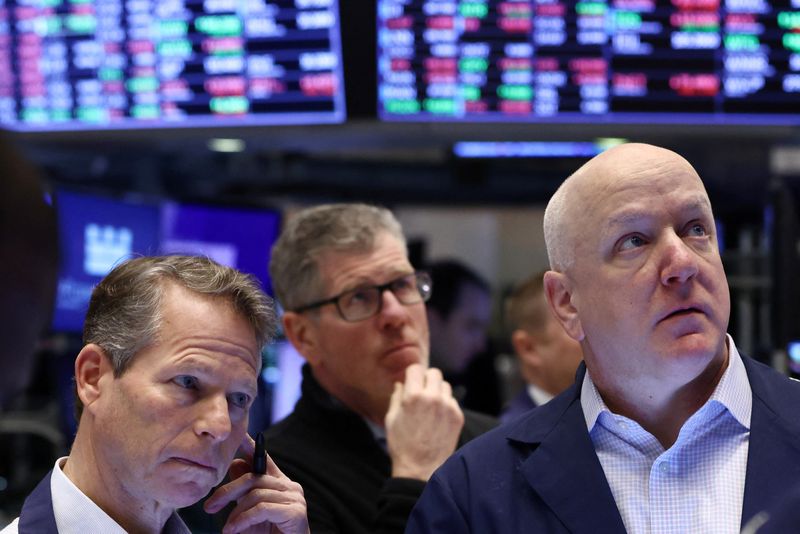By Saqib Iqbal Ahmed
NEW YORK (Reuters) - Volatility-linked funds estimated to be buying as much as $2 billion in U.S. equities daily are helping drive this year's rebound in stocks and may ramp up purchases in coming weeks, though a hawkish Federal Reserve could spoil the party.
The S&P 500’s 6.2% surge in January has been accompanied by a drop in measures of volatility across the board. Daily swings in the index over the past month were the smallest since early 2022, while the Cboe Volatility Index also stands near a one-year low.
The drop in market gyrations has triggered a buy-signal for certain computer-driven strategies including volatility control funds, risk parity funds and Commodity Trading Advisors (CTAs).
GRAPHIC: Volatility drop https://www.reuters.com/graphics/USA-STOCKS/gdvzqdqdxpw/chart.png
Broadly known as systematic strategies, these funds have been scooping up between $1 billion and $2 billion a day in U.S. stocks, according to BNP Paribas (OTC:BNPQY) estimates, helping drive an equity rally that has come despite worries that a hawkish Fed will plunge the U.S. economy into recession.
"This has definitely been more a flow-driven rally than a shift in the overall fundamental backdrop," said Max Grinacoff, U.S. equity and derivatives strategist at BNP Paribas.
Grinacoff estimates these types of funds could deploy another $50 billion-$60 billion of additional buying over the course of a month if realized volatility - a measure of daily stock swings - halves from its current level of around 16%, a level of calm unseen in U.S. stocks since late 2021.
Of course, the market will have to navigate a plethora of risks ahead - most prominently the Fed, which concludes its monetary policy meeting on Wednesday. Signs that the central bank is unlikely to pull back on its hawkish monetary policy outlook despite evidence of slowing inflation and softness in the economy could exacerbate recession fears and reignite volatility, forcing the funds to taper purchases or even start selling.
Markets widely expect the central bank to raise borrowing costs by another 25 basis points to between 4.50% and 4.75%.
Other potential pitfalls include earnings from some of the largest U.S. companies this week, including Apple Inc (NASDAQ:AAPL), Alphabet (NASDAQ:GOOGL) Inc and Meta Platforms Inc (NASDAQ:META), as well as the closely watched U.S. nonfarm payrolls report on Friday.
"As we think that technical factors may have played a large role in the market performance so far this year, we expect this to eventually wane as fundamental factors resume the dominant position as market drivers," Mark Haefele, chief investment officer at UBS Global Wealth Management, said in a note on Tuesday.
FAVORABLE CONDITIONS
Investors said conditions were supportive of a rally at the beginning of the year. The S&P 500's 19.4% drop last year, its worst annual percentage decline since 2008, had prompted market participants - including various volatility-linked strategies - to cut their equity allocations to historically low levels.
"We have this trifecta of seemingly depressed equity positioning across three major investor groups: vol target funds, CTAs and hedge funds," said Anand Omprakash, head of derivatives quantitative strategy at Elevation Securities.
Volatility control funds have raised their equity allocation to a nine-month high of 57.7%, strategists at Deutsche Bank (ETR:DBKGn) wrote on Friday.
Grinacoff, of BNP Paribas, estimates volatility control funds have assets of about $275 billion, while CTAs, not all of which have a volatility control strategy, as a group have $800 billion allocated across strategies.
While that is modest relative to the roughly $34 trillion value of the S&P 500 alone, such funds bear watching since they buy in rising markets and sell when stocks tumble, and can potentially exacerbate downside moves as well as rallies.
To be sure, while volatility has fallen from last year’s peaks, when the VIX rose as high as 36.55, current levels remain above the index’s long-term average, a sign that options investors are likely mindful of the risks ahead, said Garrett DeSimone, head of quantitative research at OptionMetrics.
"Market volatility measured by VIX remains stuck above the 18 level, which is its long-term average. This indicates a slight anxiety regarding macro outcomes on future volatility," he said.
